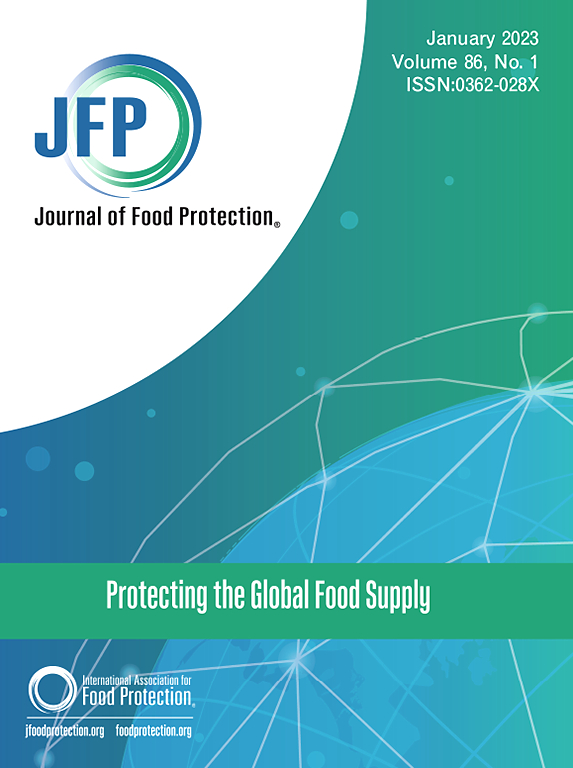Antimicrobial Resistance Profiles of Escherichia coli and Staphylococcus spp. Isolated from Locally Produced Fish and Imported Fish Sold in the Centre Region of Cameroon
IF 2.1
4区 农林科学
Q3 BIOTECHNOLOGY & APPLIED MICROBIOLOGY
引用次数: 0
Abstract
Antimicrobial resistance has emerged as a significant threat to global health, with the World Health Organization (WHO) classifying it among the top 10 public health threats. However, more epidemiological information is needed to support policy and stewardship programs. This study aimed to investigate the antimicrobial resistance profiles of Escherichia coli and Staphylococcus spp. isolated from locally produced and imported fish sold in markets in the Mfoundi Division of the Centre Region of Cameroon. A total of 11 E . coli and 28 Staphylococcus spp. strains were isolated from the 100 fish samples collected in the study area. Antimicrobial susceptibility testing was performed for 16 antimicrobial agents using the disk diffusion method. Overall, multidrug resistance rates of 54.54% (95% confidence interval: 26.9–82.1) and 60.7% (95% confidence interval: 43.7–77.7) were obtained for Escherichia coli and Staphylococcus spp., respectively. The prevalence of antimicrobial-resistant E . coli and Staphylococcus spp. strains was significantly (p < 0.05) higher in locally produced fish (18.6%; 32.6%) than in imported fish (5.3%; 24.6%). According to the WHO Essential Medicines List Access, Watch, and Reserve (AWaRe) classification, the antimicrobial resistance profile of E. coli strains isolates ranged from 5% to 45% for antimicrobials classified as Access and Watch. For Staphylococcus spp., the antimicrobial resistance profile ranges from 7% to 60% for drugs categorized as Access, whereas it ranges from 25% to 100% for drugs belonging to the Watch category. This study revealed that locally produced fish were more contaminated by antimicrobial-resistant E. coli and Staphylococcus spp. than imported fish. The continuous awareness of fish farmers about the appropriate use of aqua drugs is one of the cornerstones for reducing the risk of antimicrobial resistance related to public health.
从喀麦隆中部地区销售的本地产鱼类和进口鱼类中分离出的大肠埃希氏菌和葡萄球菌的抗菌谱。
抗菌药耐药性已成为对全球健康的重大威胁,世界卫生组织(WHO)已将其列为十大公共卫生威胁之一。然而,需要更多的流行病学信息来支持政策和管理计划。本研究旨在调查从喀麦隆中部大区姆丰迪分区市场销售的本地产和进口鱼类中分离出的大肠埃希菌和葡萄球菌的抗菌谱。在研究地区收集的 100 份鱼类样本中共分离出 11 株大肠杆菌和 28 株葡萄球菌。采用磁盘扩散法对 16 种抗菌剂进行了抗菌药敏感性测试。总体而言,大肠杆菌和葡萄球菌的多重耐药率分别为 54.54%(95% 置信区间:26.9-82.1)和 60.7%(95% 置信区间:43.7-77.7)。大肠埃希菌和葡萄球菌的抗菌药耐药性菌株的流行率显著(p
本文章由计算机程序翻译,如有差异,请以英文原文为准。
求助全文
约1分钟内获得全文
求助全文
来源期刊

Journal of food protection
工程技术-生物工程与应用微生物
CiteScore
4.20
自引率
5.00%
发文量
296
审稿时长
2.5 months
期刊介绍:
The Journal of Food Protection® (JFP) is an international, monthly scientific journal in the English language published by the International Association for Food Protection (IAFP). JFP publishes research and review articles on all aspects of food protection and safety. Major emphases of JFP are placed on studies dealing with:
Tracking, detecting (including traditional, molecular, and real-time), inactivating, and controlling food-related hazards, including microorganisms (including antibiotic resistance), microbial (mycotoxins, seafood toxins) and non-microbial toxins (heavy metals, pesticides, veterinary drug residues, migrants from food packaging, and processing contaminants), allergens and pests (insects, rodents) in human food, pet food and animal feed throughout the food chain;
Microbiological food quality and traditional/novel methods to assay microbiological food quality;
Prevention of food-related hazards and food spoilage through food preservatives and thermal/non-thermal processes, including process validation;
Food fermentations and food-related probiotics;
Safe food handling practices during pre-harvest, harvest, post-harvest, distribution and consumption, including food safety education for retailers, foodservice, and consumers;
Risk assessments for food-related hazards;
Economic impact of food-related hazards, foodborne illness, food loss, food spoilage, and adulterated foods;
Food fraud, food authentication, food defense, and foodborne disease outbreak investigations.
 求助内容:
求助内容: 应助结果提醒方式:
应助结果提醒方式:


